NURS20028 Nursing in Community: Aboriginal Women's Health Roles
VerifiedAdded on 2023/06/09
|6
|1454
|351
Report
AI Summary
This report presents a discussion among nursing students regarding the roles and responsibilities of a nurse specializing in Aboriginal women's health. The discussion covers ethical principles, NMBA guidelines, cultural safety, and practical actions for patient care. Key topics include respecting patient autonomy, maintaining confidentiality, and ensuring equity in healthcare delivery. The students emphasize the importance of cultural sensitivity, effective communication, and informed consent when working with diverse patient populations. The report also addresses challenges such as language barriers and low health literacy, highlighting the need for continuous professional development and health promotion activities tailored to the specific needs of Aboriginal women.
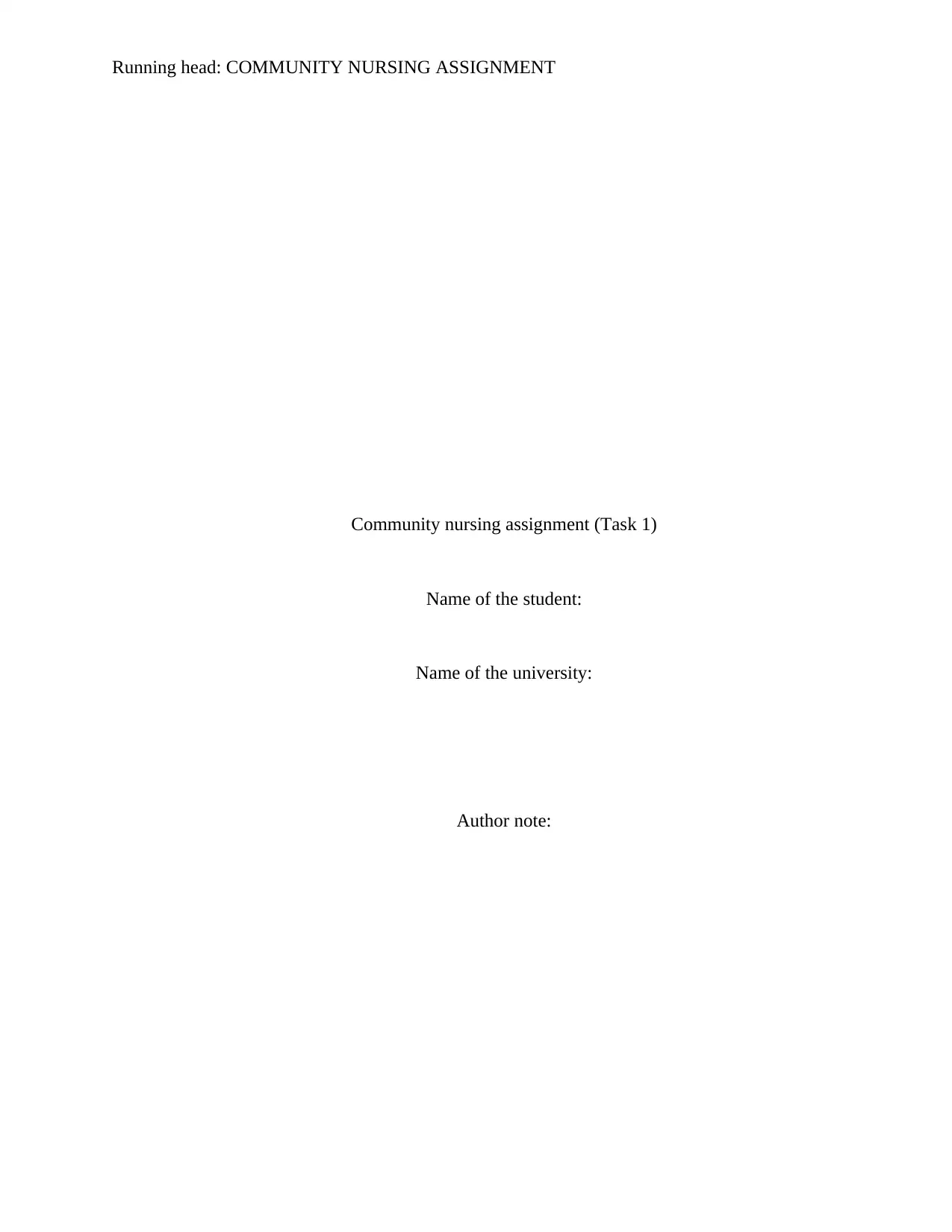
Running head: COMMUNITY NURSING ASSIGNMENT
Community nursing assignment (Task 1)
Name of the student:
Name of the university:
Author note:
Community nursing assignment (Task 1)
Name of the student:
Name of the university:
Author note:
Paraphrase This Document
Need a fresh take? Get an instant paraphrase of this document with our AI Paraphraser
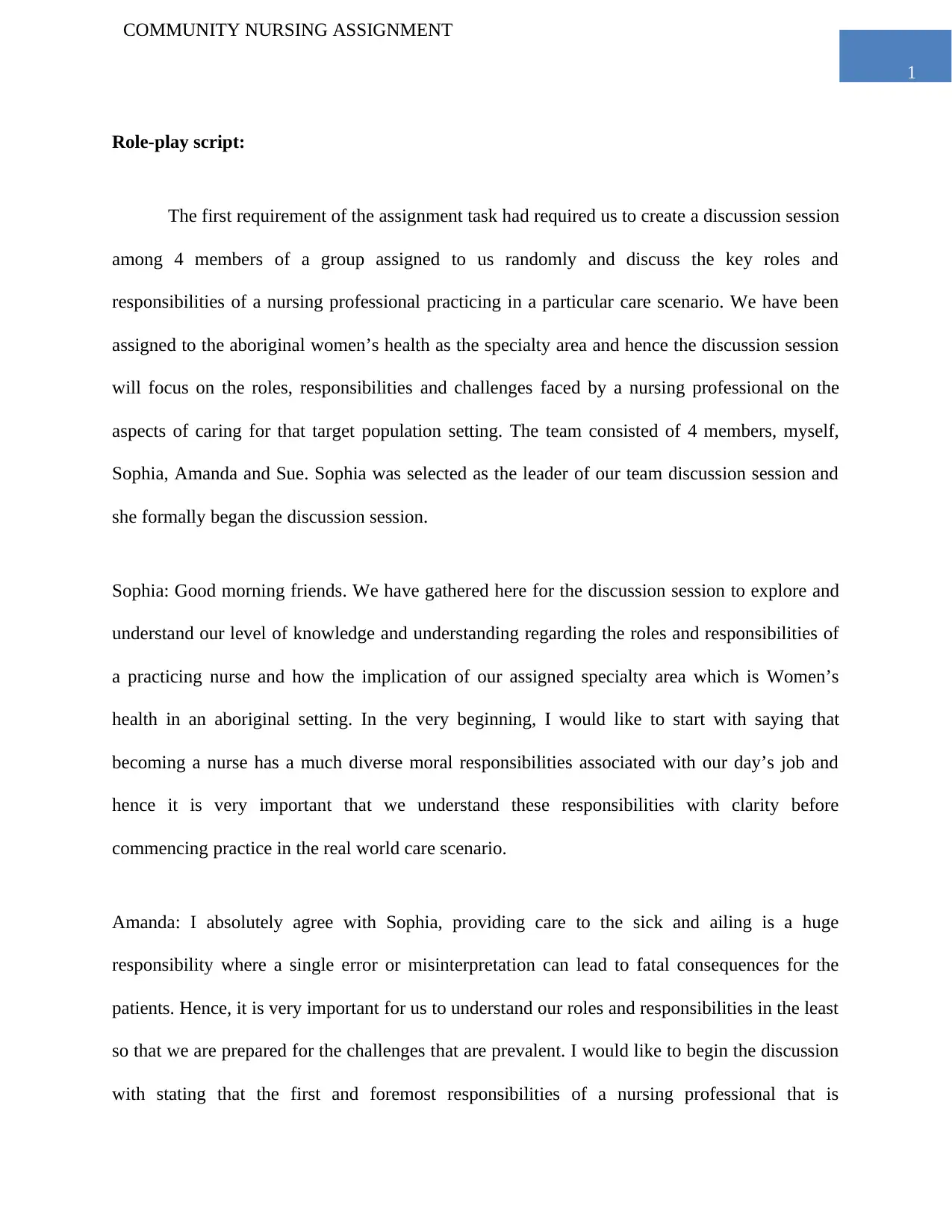
1
COMMUNITY NURSING ASSIGNMENT
Role-play script:
The first requirement of the assignment task had required us to create a discussion session
among 4 members of a group assigned to us randomly and discuss the key roles and
responsibilities of a nursing professional practicing in a particular care scenario. We have been
assigned to the aboriginal women’s health as the specialty area and hence the discussion session
will focus on the roles, responsibilities and challenges faced by a nursing professional on the
aspects of caring for that target population setting. The team consisted of 4 members, myself,
Sophia, Amanda and Sue. Sophia was selected as the leader of our team discussion session and
she formally began the discussion session.
Sophia: Good morning friends. We have gathered here for the discussion session to explore and
understand our level of knowledge and understanding regarding the roles and responsibilities of
a practicing nurse and how the implication of our assigned specialty area which is Women’s
health in an aboriginal setting. In the very beginning, I would like to start with saying that
becoming a nurse has a much diverse moral responsibilities associated with our day’s job and
hence it is very important that we understand these responsibilities with clarity before
commencing practice in the real world care scenario.
Amanda: I absolutely agree with Sophia, providing care to the sick and ailing is a huge
responsibility where a single error or misinterpretation can lead to fatal consequences for the
patients. Hence, it is very important for us to understand our roles and responsibilities in the least
so that we are prepared for the challenges that are prevalent. I would like to begin the discussion
with stating that the first and foremost responsibilities of a nursing professional that is
COMMUNITY NURSING ASSIGNMENT
Role-play script:
The first requirement of the assignment task had required us to create a discussion session
among 4 members of a group assigned to us randomly and discuss the key roles and
responsibilities of a nursing professional practicing in a particular care scenario. We have been
assigned to the aboriginal women’s health as the specialty area and hence the discussion session
will focus on the roles, responsibilities and challenges faced by a nursing professional on the
aspects of caring for that target population setting. The team consisted of 4 members, myself,
Sophia, Amanda and Sue. Sophia was selected as the leader of our team discussion session and
she formally began the discussion session.
Sophia: Good morning friends. We have gathered here for the discussion session to explore and
understand our level of knowledge and understanding regarding the roles and responsibilities of
a practicing nurse and how the implication of our assigned specialty area which is Women’s
health in an aboriginal setting. In the very beginning, I would like to start with saying that
becoming a nurse has a much diverse moral responsibilities associated with our day’s job and
hence it is very important that we understand these responsibilities with clarity before
commencing practice in the real world care scenario.
Amanda: I absolutely agree with Sophia, providing care to the sick and ailing is a huge
responsibility where a single error or misinterpretation can lead to fatal consequences for the
patients. Hence, it is very important for us to understand our roles and responsibilities in the least
so that we are prepared for the challenges that are prevalent. I would like to begin the discussion
with stating that the first and foremost responsibilities of a nursing professional that is
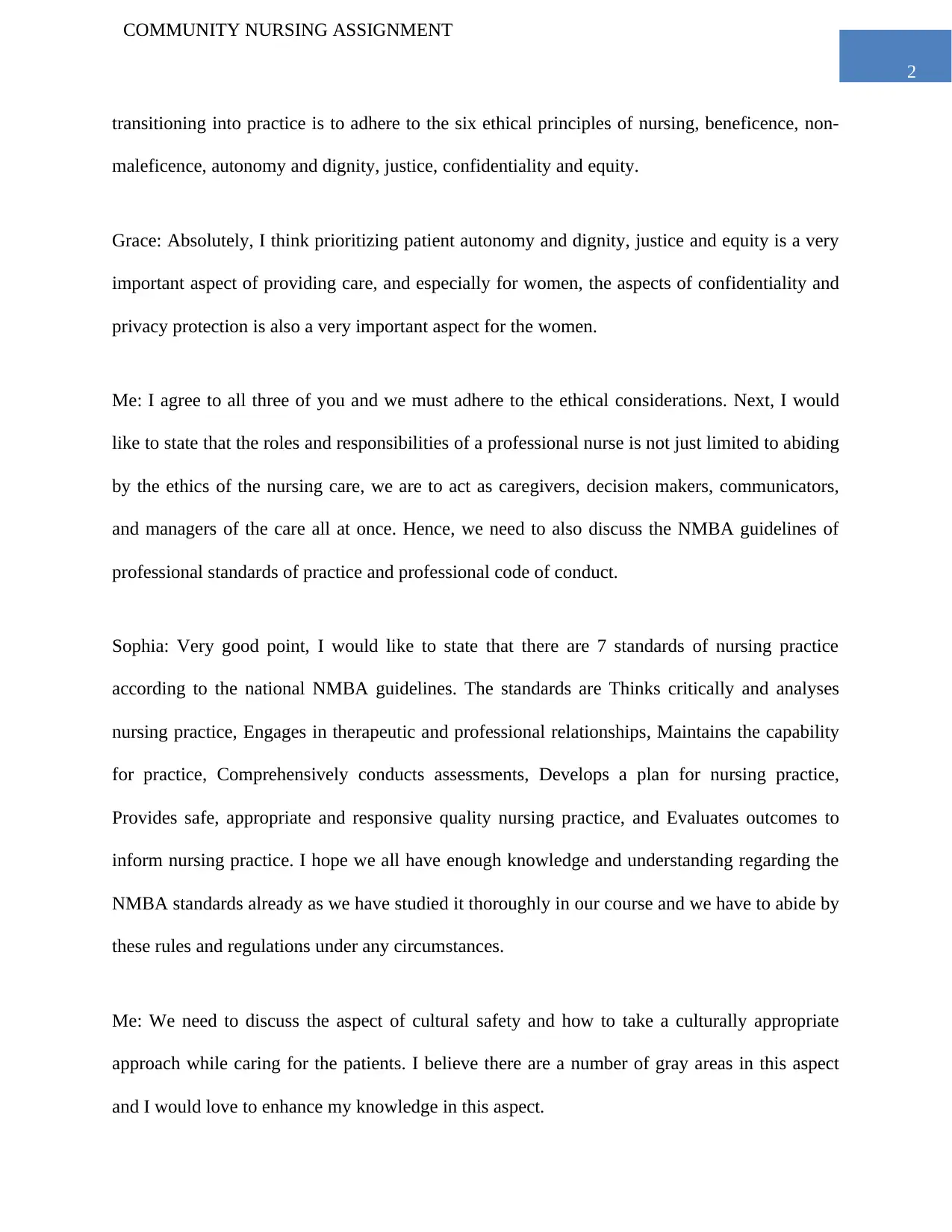
2
COMMUNITY NURSING ASSIGNMENT
transitioning into practice is to adhere to the six ethical principles of nursing, beneficence, non-
maleficence, autonomy and dignity, justice, confidentiality and equity.
Grace: Absolutely, I think prioritizing patient autonomy and dignity, justice and equity is a very
important aspect of providing care, and especially for women, the aspects of confidentiality and
privacy protection is also a very important aspect for the women.
Me: I agree to all three of you and we must adhere to the ethical considerations. Next, I would
like to state that the roles and responsibilities of a professional nurse is not just limited to abiding
by the ethics of the nursing care, we are to act as caregivers, decision makers, communicators,
and managers of the care all at once. Hence, we need to also discuss the NMBA guidelines of
professional standards of practice and professional code of conduct.
Sophia: Very good point, I would like to state that there are 7 standards of nursing practice
according to the national NMBA guidelines. The standards are Thinks critically and analyses
nursing practice, Engages in therapeutic and professional relationships, Maintains the capability
for practice, Comprehensively conducts assessments, Develops a plan for nursing practice,
Provides safe, appropriate and responsive quality nursing practice, and Evaluates outcomes to
inform nursing practice. I hope we all have enough knowledge and understanding regarding the
NMBA standards already as we have studied it thoroughly in our course and we have to abide by
these rules and regulations under any circumstances.
Me: We need to discuss the aspect of cultural safety and how to take a culturally appropriate
approach while caring for the patients. I believe there are a number of gray areas in this aspect
and I would love to enhance my knowledge in this aspect.
COMMUNITY NURSING ASSIGNMENT
transitioning into practice is to adhere to the six ethical principles of nursing, beneficence, non-
maleficence, autonomy and dignity, justice, confidentiality and equity.
Grace: Absolutely, I think prioritizing patient autonomy and dignity, justice and equity is a very
important aspect of providing care, and especially for women, the aspects of confidentiality and
privacy protection is also a very important aspect for the women.
Me: I agree to all three of you and we must adhere to the ethical considerations. Next, I would
like to state that the roles and responsibilities of a professional nurse is not just limited to abiding
by the ethics of the nursing care, we are to act as caregivers, decision makers, communicators,
and managers of the care all at once. Hence, we need to also discuss the NMBA guidelines of
professional standards of practice and professional code of conduct.
Sophia: Very good point, I would like to state that there are 7 standards of nursing practice
according to the national NMBA guidelines. The standards are Thinks critically and analyses
nursing practice, Engages in therapeutic and professional relationships, Maintains the capability
for practice, Comprehensively conducts assessments, Develops a plan for nursing practice,
Provides safe, appropriate and responsive quality nursing practice, and Evaluates outcomes to
inform nursing practice. I hope we all have enough knowledge and understanding regarding the
NMBA standards already as we have studied it thoroughly in our course and we have to abide by
these rules and regulations under any circumstances.
Me: We need to discuss the aspect of cultural safety and how to take a culturally appropriate
approach while caring for the patients. I believe there are a number of gray areas in this aspect
and I would love to enhance my knowledge in this aspect.
⊘ This is a preview!⊘
Do you want full access?
Subscribe today to unlock all pages.

Trusted by 1+ million students worldwide
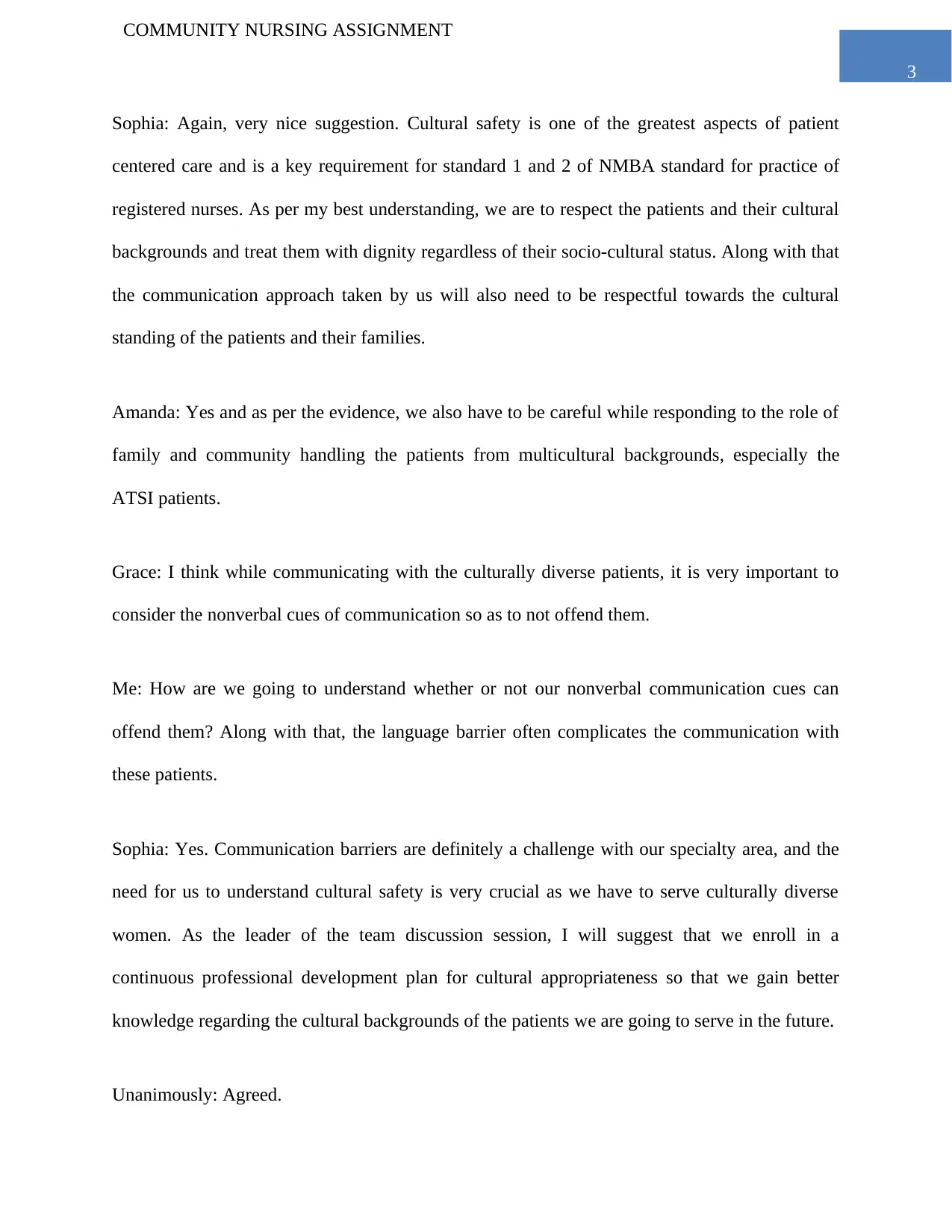
3
COMMUNITY NURSING ASSIGNMENT
Sophia: Again, very nice suggestion. Cultural safety is one of the greatest aspects of patient
centered care and is a key requirement for standard 1 and 2 of NMBA standard for practice of
registered nurses. As per my best understanding, we are to respect the patients and their cultural
backgrounds and treat them with dignity regardless of their socio-cultural status. Along with that
the communication approach taken by us will also need to be respectful towards the cultural
standing of the patients and their families.
Amanda: Yes and as per the evidence, we also have to be careful while responding to the role of
family and community handling the patients from multicultural backgrounds, especially the
ATSI patients.
Grace: I think while communicating with the culturally diverse patients, it is very important to
consider the nonverbal cues of communication so as to not offend them.
Me: How are we going to understand whether or not our nonverbal communication cues can
offend them? Along with that, the language barrier often complicates the communication with
these patients.
Sophia: Yes. Communication barriers are definitely a challenge with our specialty area, and the
need for us to understand cultural safety is very crucial as we have to serve culturally diverse
women. As the leader of the team discussion session, I will suggest that we enroll in a
continuous professional development plan for cultural appropriateness so that we gain better
knowledge regarding the cultural backgrounds of the patients we are going to serve in the future.
Unanimously: Agreed.
COMMUNITY NURSING ASSIGNMENT
Sophia: Again, very nice suggestion. Cultural safety is one of the greatest aspects of patient
centered care and is a key requirement for standard 1 and 2 of NMBA standard for practice of
registered nurses. As per my best understanding, we are to respect the patients and their cultural
backgrounds and treat them with dignity regardless of their socio-cultural status. Along with that
the communication approach taken by us will also need to be respectful towards the cultural
standing of the patients and their families.
Amanda: Yes and as per the evidence, we also have to be careful while responding to the role of
family and community handling the patients from multicultural backgrounds, especially the
ATSI patients.
Grace: I think while communicating with the culturally diverse patients, it is very important to
consider the nonverbal cues of communication so as to not offend them.
Me: How are we going to understand whether or not our nonverbal communication cues can
offend them? Along with that, the language barrier often complicates the communication with
these patients.
Sophia: Yes. Communication barriers are definitely a challenge with our specialty area, and the
need for us to understand cultural safety is very crucial as we have to serve culturally diverse
women. As the leader of the team discussion session, I will suggest that we enroll in a
continuous professional development plan for cultural appropriateness so that we gain better
knowledge regarding the cultural backgrounds of the patients we are going to serve in the future.
Unanimously: Agreed.
Paraphrase This Document
Need a fresh take? Get an instant paraphrase of this document with our AI Paraphraser
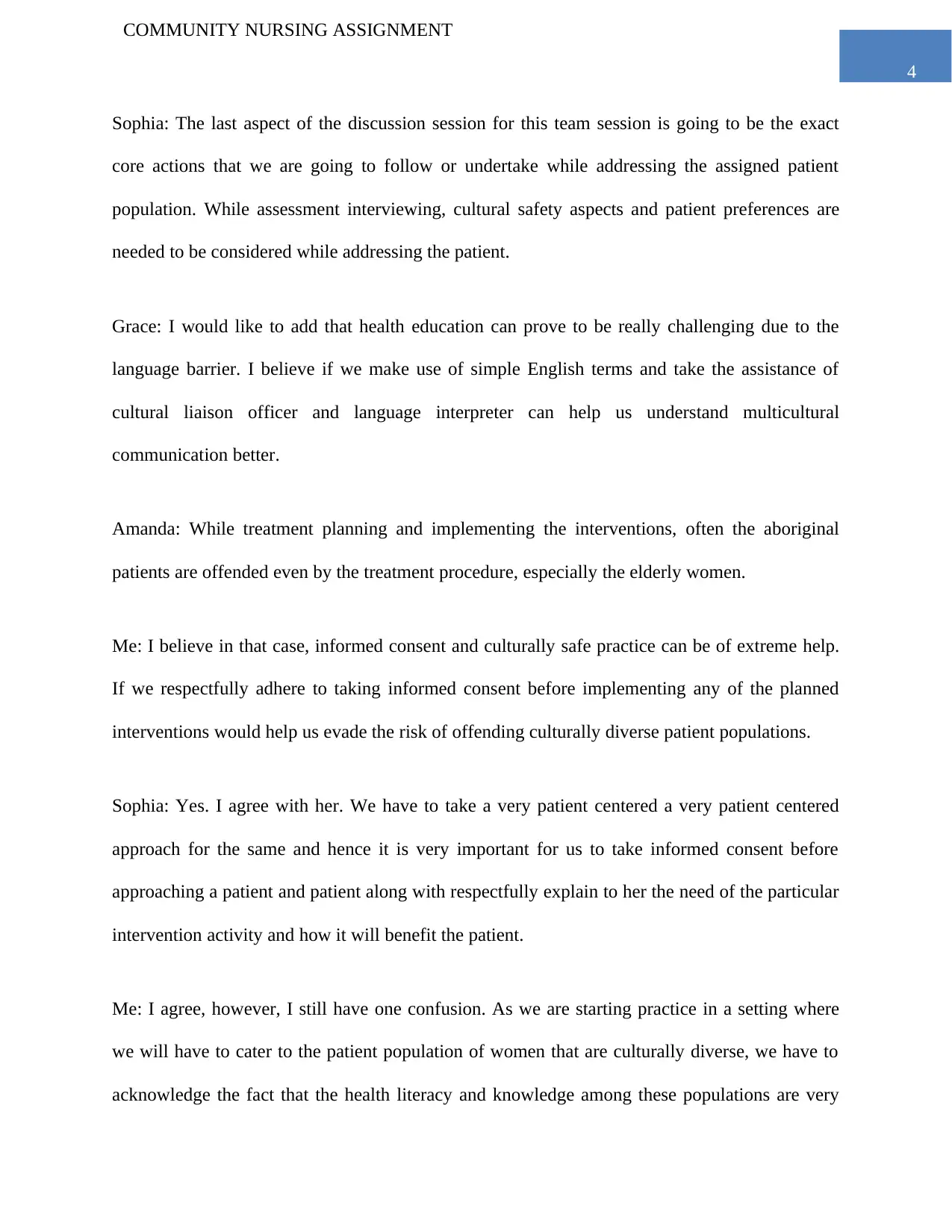
4
COMMUNITY NURSING ASSIGNMENT
Sophia: The last aspect of the discussion session for this team session is going to be the exact
core actions that we are going to follow or undertake while addressing the assigned patient
population. While assessment interviewing, cultural safety aspects and patient preferences are
needed to be considered while addressing the patient.
Grace: I would like to add that health education can prove to be really challenging due to the
language barrier. I believe if we make use of simple English terms and take the assistance of
cultural liaison officer and language interpreter can help us understand multicultural
communication better.
Amanda: While treatment planning and implementing the interventions, often the aboriginal
patients are offended even by the treatment procedure, especially the elderly women.
Me: I believe in that case, informed consent and culturally safe practice can be of extreme help.
If we respectfully adhere to taking informed consent before implementing any of the planned
interventions would help us evade the risk of offending culturally diverse patient populations.
Sophia: Yes. I agree with her. We have to take a very patient centered a very patient centered
approach for the same and hence it is very important for us to take informed consent before
approaching a patient and patient along with respectfully explain to her the need of the particular
intervention activity and how it will benefit the patient.
Me: I agree, however, I still have one confusion. As we are starting practice in a setting where
we will have to cater to the patient population of women that are culturally diverse, we have to
acknowledge the fact that the health literacy and knowledge among these populations are very
COMMUNITY NURSING ASSIGNMENT
Sophia: The last aspect of the discussion session for this team session is going to be the exact
core actions that we are going to follow or undertake while addressing the assigned patient
population. While assessment interviewing, cultural safety aspects and patient preferences are
needed to be considered while addressing the patient.
Grace: I would like to add that health education can prove to be really challenging due to the
language barrier. I believe if we make use of simple English terms and take the assistance of
cultural liaison officer and language interpreter can help us understand multicultural
communication better.
Amanda: While treatment planning and implementing the interventions, often the aboriginal
patients are offended even by the treatment procedure, especially the elderly women.
Me: I believe in that case, informed consent and culturally safe practice can be of extreme help.
If we respectfully adhere to taking informed consent before implementing any of the planned
interventions would help us evade the risk of offending culturally diverse patient populations.
Sophia: Yes. I agree with her. We have to take a very patient centered a very patient centered
approach for the same and hence it is very important for us to take informed consent before
approaching a patient and patient along with respectfully explain to her the need of the particular
intervention activity and how it will benefit the patient.
Me: I agree, however, I still have one confusion. As we are starting practice in a setting where
we will have to cater to the patient population of women that are culturally diverse, we have to
acknowledge the fact that the health literacy and knowledge among these populations are very
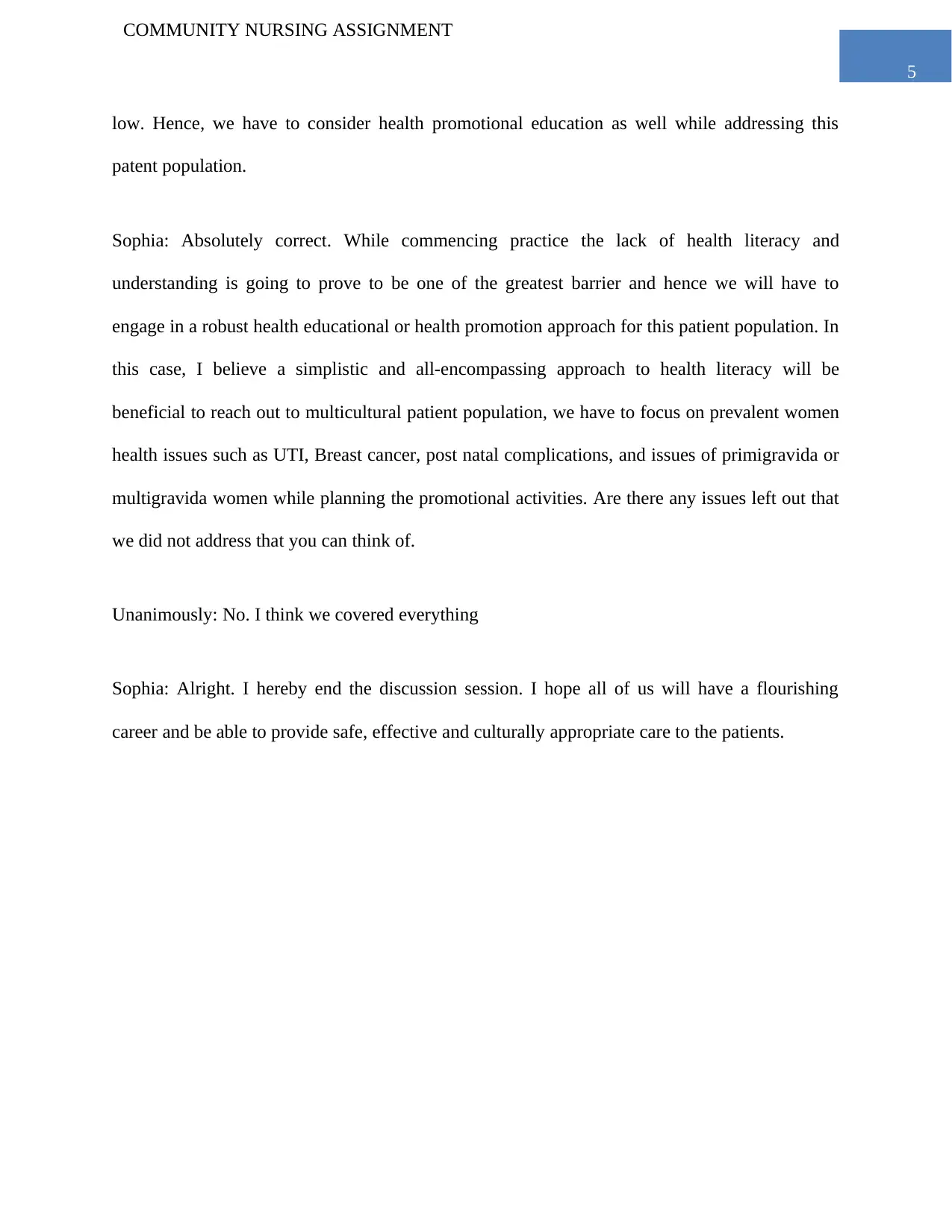
5
COMMUNITY NURSING ASSIGNMENT
low. Hence, we have to consider health promotional education as well while addressing this
patent population.
Sophia: Absolutely correct. While commencing practice the lack of health literacy and
understanding is going to prove to be one of the greatest barrier and hence we will have to
engage in a robust health educational or health promotion approach for this patient population. In
this case, I believe a simplistic and all-encompassing approach to health literacy will be
beneficial to reach out to multicultural patient population, we have to focus on prevalent women
health issues such as UTI, Breast cancer, post natal complications, and issues of primigravida or
multigravida women while planning the promotional activities. Are there any issues left out that
we did not address that you can think of.
Unanimously: No. I think we covered everything
Sophia: Alright. I hereby end the discussion session. I hope all of us will have a flourishing
career and be able to provide safe, effective and culturally appropriate care to the patients.
COMMUNITY NURSING ASSIGNMENT
low. Hence, we have to consider health promotional education as well while addressing this
patent population.
Sophia: Absolutely correct. While commencing practice the lack of health literacy and
understanding is going to prove to be one of the greatest barrier and hence we will have to
engage in a robust health educational or health promotion approach for this patient population. In
this case, I believe a simplistic and all-encompassing approach to health literacy will be
beneficial to reach out to multicultural patient population, we have to focus on prevalent women
health issues such as UTI, Breast cancer, post natal complications, and issues of primigravida or
multigravida women while planning the promotional activities. Are there any issues left out that
we did not address that you can think of.
Unanimously: No. I think we covered everything
Sophia: Alright. I hereby end the discussion session. I hope all of us will have a flourishing
career and be able to provide safe, effective and culturally appropriate care to the patients.
⊘ This is a preview!⊘
Do you want full access?
Subscribe today to unlock all pages.

Trusted by 1+ million students worldwide
1 out of 6
Related Documents
Your All-in-One AI-Powered Toolkit for Academic Success.
+13062052269
info@desklib.com
Available 24*7 on WhatsApp / Email
![[object Object]](/_next/static/media/star-bottom.7253800d.svg)
Unlock your academic potential
Copyright © 2020–2025 A2Z Services. All Rights Reserved. Developed and managed by ZUCOL.





